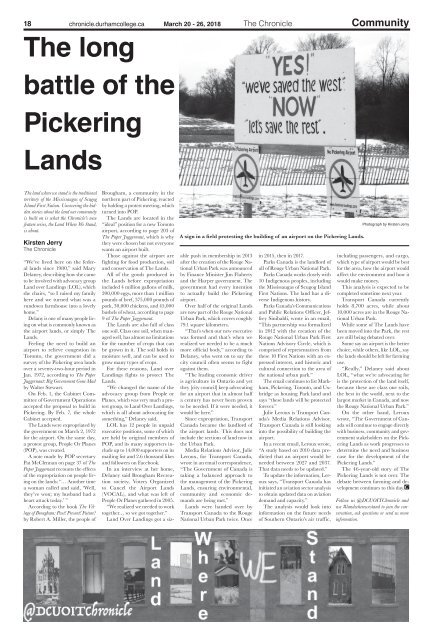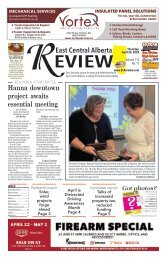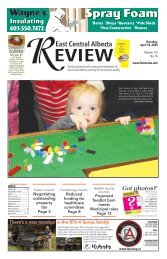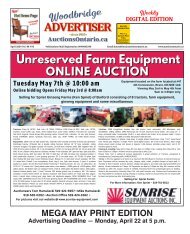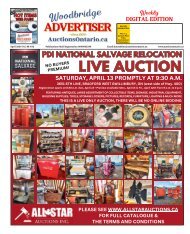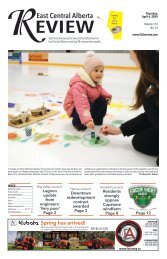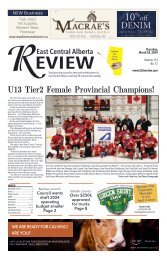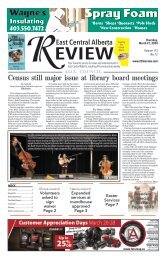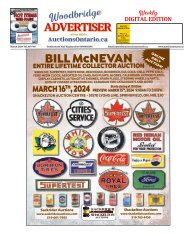You also want an ePaper? Increase the reach of your titles
YUMPU automatically turns print PDFs into web optimized ePapers that Google loves.
18 chronicle.durhamcollege.ca March 20 - 26, 2018 The <strong>Chronicle</strong> Community<br />
The long<br />
battle of the<br />
Pickering<br />
Lands<br />
The land where we stand is the traditional<br />
territory of the Mississaugas of Scugog<br />
Island First Nation. Uncovering the hidden<br />
stories about the land our community<br />
is built on is what the <strong>Chronicle</strong>'s new<br />
feature series, the Land Where We Stand,<br />
is about.<br />
Kirsten Jerry<br />
The <strong>Chronicle</strong><br />
“We’ve lived here on the federal<br />
lands since 1980,” said Mary<br />
Delaney, describing how she came<br />
to be involved with advocacy group<br />
Land over Landings (LOL), which<br />
she chairs, “so I raised my family<br />
here and we turned what was a<br />
rundown farmhouse into a lovely<br />
home.”<br />
Delany is one of many people living<br />
on what is commonly known as<br />
the airport lands, or simply The<br />
Lands.<br />
Feeling the need to build an<br />
airport to relieve congestion in<br />
Toronto, the government did a<br />
survey of the Pickering area lands<br />
over a seventy-two-hour period in<br />
Jan. 1972, according to The Paper<br />
Juggernaut: Big Government Gone Mad<br />
by Walter Stewart.<br />
On Feb. 1, the Cabinet Committee<br />
of Government Operations<br />
accepted the proposal to build in<br />
Pickering. By Feb. 7, the whole<br />
Cabinet accepted.<br />
The Lands were expropriated by<br />
the government on March 2, 1972<br />
for the airport. On the same day,<br />
a protest group, People Or Planes<br />
(POP), was created.<br />
A note made by POP secretary<br />
Pat McClennan on page 37 of The<br />
Paper Juggernaut recounts the effects<br />
of the expropriation on people living<br />
on the lands: “… Another time<br />
a woman c<strong>all</strong>ed and said, ‘Well,<br />
they’ve won; my husband had a<br />
heart attack today.’ ”<br />
According to the book The Village<br />
of Brougham: Past! Present! Future?<br />
by Robert A. Miller, the people of<br />
A sign in a field protesting the building of an airport on the Pickering Lands.<br />
Brougham, a community in the<br />
northern part of Pickering, reacted<br />
by holding a protest meeting, which<br />
turned into POP.<br />
The Lands are located in the<br />
“ideal” position for a new Toronto<br />
airport, according to page 203 of<br />
The Paper Juggernaut, which is why<br />
they were chosen but not everyone<br />
wants an airport built.<br />
Those against the airport are<br />
fighting for food production, soil<br />
and conservation of The Lands.<br />
All of the goods produced in<br />
the Lands before expropriation<br />
included 4 million g<strong>all</strong>ons of milk,<br />
200,000 eggs, more than 1 million<br />
pounds of beef, 375,000 pounds of<br />
pork, 30,000 chickens, and 45,000<br />
bushels of wheat, according to page<br />
9 of The Paper Juggernaut.<br />
The Lands are also full of class<br />
one soil. Class one soil, when managed<br />
well, has almost no limitations<br />
for the number of crops that can<br />
be grown in it. The soil holds in<br />
moisture well, and can be used to<br />
grow many types of crops.<br />
For these reasons, Land over<br />
Landings fights to protect The<br />
Lands.<br />
“We changed the name of the<br />
advocacy group from People or<br />
Planes, which was very much a protest<br />
group, to Land Over Landings,<br />
which is <strong>all</strong> about advocating for<br />
something,” Delaney said.<br />
LOL has 12 people in unpaid<br />
executive positions, some of which<br />
are held by original members of<br />
POP, and its many supporters include<br />
up to 14,000 supporters on its<br />
mailing list and 2.6 thousand likes<br />
and followers on Facebook.<br />
In an interview at her home,<br />
Delaney said Brougham Recreation<br />
society, Voters Organized<br />
to Cancel the Airport Lands<br />
(VOCAL), and what was left of<br />
People Or Planes gathered in 2005.<br />
“We realized we needed to work<br />
together… so we got together.”<br />
Land Over Landings got a sizable<br />
push in membership in 2013<br />
after the creation of the Rouge National<br />
Urban Park was announced<br />
by Finance Minister Jim Flaherty<br />
and the Harper government. The<br />
government had every intention<br />
to actu<strong>all</strong>y build the Pickering<br />
airport.<br />
Over half of the original Lands<br />
are now part of the Rouge National<br />
Urban Park, which covers roughly<br />
79.1 square kilometers.<br />
“That’s when our new executive<br />
was formed and that’s when we<br />
realized we needed to be a much<br />
more official body,” according to<br />
Delaney, who went on to say the<br />
city council often seems to fight<br />
against them.<br />
“The leading economic driver<br />
is agriculture in Ontario and yet<br />
they [city council] keep advocating<br />
for an airport that in almost half<br />
a century has never been proven<br />
to be needed. If it were needed, it<br />
would be here.”<br />
Since expropriation, Transport<br />
Canada became the landlord of<br />
the airport lands. This does not<br />
include the sections of land now in<br />
the Urban Park.<br />
Media Relations Advisor, Julie<br />
Leroux, for Transport Canada,<br />
wrote in an email correspondence,<br />
“The Government of Canada is<br />
taking a balanced approach to<br />
the management of the Pickering<br />
Lands, ensuring environmental,<br />
community and economic demands<br />
are being met.”<br />
Lands were handed over by<br />
Transport Canada to the Rouge<br />
National Urban Park twice. Once<br />
in 2015, then in 2017.<br />
Parks Canada is the landlord of<br />
<strong>all</strong> of Rouge Urban National Park.<br />
Parks Canada works closely with<br />
10 Indigenous peoples, including<br />
the Mississaugas of Scugog Island<br />
First Nations. The land has a diverse<br />
Indigenous history.<br />
Parks Canada’s Communications<br />
and Public Relations Officer, Jeffrey<br />
Sinibaldi, wrote in an email,<br />
“This partnership was formalized<br />
in 2012 with the creation of the<br />
Rouge National Urban Park First<br />
Nations Advisory Circle, which is<br />
comprised of representatives from<br />
these 10 First Nations with an expressed<br />
interest, and historic and<br />
cultural connection to the area of<br />
the national urban park.”<br />
The email continues to list Markham,<br />
Pickering, Toronto, and Uxbridge<br />
as housing Park land and<br />
says “these lands will be protected<br />
forever.”<br />
Julie Leroux is Transport Canada’s<br />
Media Relations Advisor.<br />
Transport Canada is still looking<br />
into the possibility of building the<br />
airport.<br />
In a recent email, Leroux wrote,<br />
“A study based on 2010 data predicted<br />
that an airport would be<br />
needed between 2027 and 2037.<br />
That data needs to be updated.”<br />
To update the information, Leroux<br />
says, “Transport Canada has<br />
initiated an aviation sector analysis<br />
to obtain updated data on aviation<br />
demand and capacity.”<br />
The analysis would look into<br />
information on the future needs<br />
of Southern Ontario’s air traffic,<br />
Photograph by Kirsten Jerry<br />
including passengers, and cargo,<br />
which type of airport would be best<br />
for the area, how the airport would<br />
affect the environment and how it<br />
would make money.<br />
This analysis is expected to be<br />
completed sometime next year.<br />
Transport Canada currently<br />
holds 8,700 acres, while about<br />
10,000 acres are in the Rouge National<br />
Urban Park.<br />
While some of The Lands have<br />
been moved into the Park, the rest<br />
are still being debated over.<br />
Some say an airport is the better<br />
choice, while others, like LOL, say<br />
the lands should be left for farming<br />
use.<br />
“Re<strong>all</strong>y,” Delaney said about<br />
LOL, “what we’re advocating for<br />
is the protection of the land itself,<br />
because these are class one soils,<br />
the best in the world, next to the<br />
largest market in Canada, and now<br />
the Rouge National Urban Park.”<br />
On the other hand, Leroux<br />
wrote, “The Government of Canada<br />
will continue to engage directly<br />
with business, community and government<br />
stakeholders on the Pickering<br />
Lands as work progresses to<br />
determine the need and business<br />
case for the development of the<br />
Pickering Lands.”<br />
The 46-year-old story of The<br />
Pickering Lands is not over. The<br />
debate between farming and development<br />
continues to this day.<br />
Follow us @DCUOIT<strong>Chronicle</strong> and<br />
use #landwherewestand to join the conversation,<br />
ask questions or send us more<br />
information.


